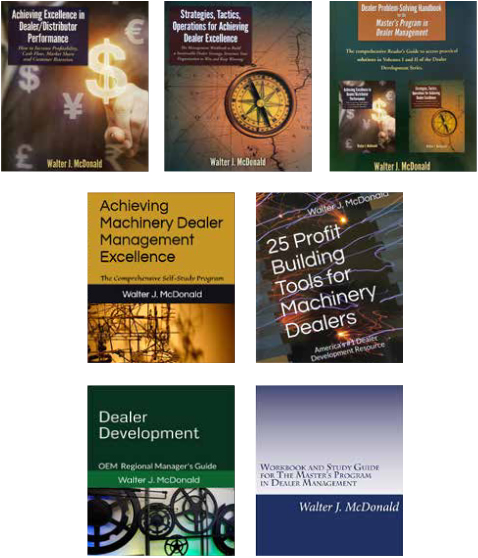The Master’s Program in
Machinery Dealer Management
The Master’s Program in Dealer Management is a 16 module personalized, distance learning training program with a curriculum track for machinery dealer distribution executives and managers and a track for OEM customer contact managers and distributor executives. By the end of the course, you’ll have an effective action plan to boost sales, profitability, and growth in each dealer revenue center, as well as strengthen dealer market position and dealer-OEM relationships.
A Certificate in Machinery Dealer Development will be awarded upon successful completion of all course and study requirements. Mr. McDonald will work personally with each participant on assignments, discussion sessions and study projects in each module.
How the program will benefit your dealership
- Quantitatively Benchmark Operations against High-Profit Dealers
- Qualitatively Audit Best Practices in Each Revenue Center
- Strengthen Machinery Sales, Margins, Deal Visibility (Awareness or Participation Rate), and Closure Rates
- Improve Dealer Profitability, Cash Flow, Return on Assets
- Sharpen Teamwork, Build Management Problem-Solving Skills
- Build Momentum Required to Achieve Aggressive Aftermarket Service and Parts Sales, Gross Profit Margin Targets and 100% Absorption Rate.
- Create a Roadmap for Building a High-performance Dealer Organization
- Assess Utilization of Information Technology as a Competitive Weapon
- Audit each Revenue Center’s operations against our detailed high-performance dealer BEST PRACTICES checklist.
- Identify and discuss the critical success factors for each Revenue Center that contribute to enhanced cash flow, profitability and improved market share, especially After-Sales Operations.
- Develop ACTION PLANS to improve sales, profitability, and growth in each Revenue Center. Build performance improvement plans critical to your success.

What our clients are saying about the program
“The completion of Walter’s dealer management training program will be like adding ten years of experiential knowledge to your middle management team. There will be a significant increase in dealer financial performance when these practices are put into play.”
Walter Clark, General Manager, C.I. Walker/Whayne Supply
“These are the only independent dealer operations manuals dedicated specifically to the materials handling lift truck industry we are aware of. Walt has collected over forty years of dealership ‘best practices and assembled them into a series of easy-to-follow workbooks.”
– Bill Ryan, former President LiftOne LLC, Industry Advisor
Tuition for the Master’s Program in Machinery Dealer Development
Dealer Track US $1,295.00
Executive Program in Dealer Management – Distance Learning with Private Tutoring by Walter J. McDonald (Including 8 Required Textbooks)
Tuition for 16-module personalized, private distance learning dealer management training program including the 8 volume Master’s Program in Dealer Management book set by Walter McDonald.
OEM Track US $2,500.00
Master’s Program in Dealer Management – Distance Learning with Private Tutoring by Walter J. McDonald (Including 9 Required Textbooks)
Tuition for 16-module personalized, private distance learning OEM management training program including the 8 volume Master’s Program in Dealer Management book set plus the newly released 507 page Dealer Development: The OEM Regional (Sales and Product Support) Management Guide by Walter McDonald,
